May 31, 2023 – Volume 25, Issue 5
In This Issue
- Flanigan’s Net Positive: The Land of Enchantment
- Global Clothing Glut
- Seaweed Clothing
- South Korea’s Solar Bike Path
- Plugging Into Streetlights
- EV Highlights from Oakland and Shenzhen
- Batteries Becoming Largest Form of Grid-Scale Storage
- Flanigan’s Eco-Logic Podcast Updates
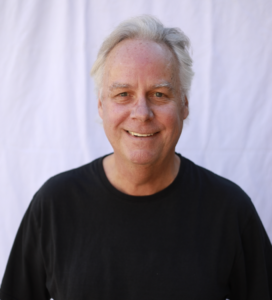
Flanigan’s Net Positive: The Land of Enchantment
Santa Fe, New Mexico.. What a town! What a state… the land of enchantment. Daughter Sierra is living there now with her man Alex, so off we went to check out the scene.
She’s thriving in her new sphere… a really hip town, overflowing with art that she loves and rich in southwestern culture. We see her their new casita, visit her friend Amber’s home and family, check out her workspace, meet her coworkers, stay in one of Santa Fe’s classic hotels on the plaza, eat lots of delicious New Mexico cuisine, and hang and bond with Alex’s family.

One day we visited Ojo Caliente near Taos. We had a few hours of full sunshine before the late afternoon sun gave way to the golden and orange and red colors of sunset, casting artful lights in shades on the hills and rock. Ojo Caliente is about an hour north of Santa Fee; on the way we pass a turn to Los Alamos. The hot springs are beautiful, nestled into the rocks, springs of varying temperature and minerals. We soak for hours… in and out of pools. We slather on mud in the mud bath. What an afternoon and sunset with intermittent sunning on chaise lounges, watching to the west as the day drew to a close. As the temperature dropped, we made our way to the cafe, where locally grown organic veggies and salads are featured and consumed.
Santa Fe boasts that it is the oldest capital in the United States. It was originally a Mexican territorial capitol, founded in 1610 as the capitol of Nuevo Mexico. In 1846, the United States declared war on Mexico which led to the annexation of Texas and then New Mexico in 1848. New Mexico officially became the 47th state in January of 1912.
Santa Fe had a population of 87,505 at the time of its last census in 2020. It is the fourth most populous city in New Mexico after Albuquerque, Las Cruces, and Rio Rancho. Santa Fe is at an altitude of 7,200 feet and has its own ski area – Ski Santa Fe – with a base elevation of 10,350 and runs that begin at 12,000 feet. Taos is about an hour away.
In terms of size, New Mexico is the 10th largest U.S. state. Its 2.1 million people make it the 36th in terms of population. It features huge open expanses of desert, as well as mountainous forests, nearly all devoid of humanity. The Rio Grande River flows south through the State, its valley bisecting the state. One third of its land area is federally owned. The State is also home to the Sandia and Los Alamos national laboratories. It was the site of our nation’s first nuclear testing; the labs played key roles in the Manhattan Project.

Georgia O’Keeffe is a treasured soul in Santa Fe. We’re tempted, buy a hat, and stroll from the plaza and visit the Georgia O’Keefe museum. Considered a modernist artist, O’Keeffe had a 70-year career in art. She was called “the mother of American modernism.” Born in Wisconsin, she studied and lived in Chicago, Virginia, and New York City where she had a long professional and personal relationship with art dealer and photographer Alfred Stieglitz.

O’Keefe remained in New York until 1929, then began to spend more time in the southwest, her art impressed upon by images of animal skulls, and dried twisted tree limbs and trunks. After Albert Stieglitz’s death in 1946, O’Keefe was in New Mexico for the next 40 years until 1986. She was drawn to New Mexico and loved its light, the sun’s colors on the desert rocks and skies. The museum is well done, her art and personality impressed upon us.
New Mexico has the second highest percentage of Native Americans of all U.S. states. Only Alaska has a higher percentage. The current population of Native Americans is 263,614, 12.4% of the State’s population. There are 23 Indian tribes in New Mexico, nineteen Pueblos, three Apaches, and the Navajo Nation, the largest of New Mexico’s tribes. Each tribe is a sovereign nation with its own government, lifestyles, traditions, and culture. Events held on Tribal lands are open to the public, at the Tribal communities’ discretion.

New Mexico is called the Land of Enchantment… known for its wonderful vistas and expanses that humble humanity. Its ski areas boast best-in-class powder snow. Beneath the surface, New Mexico has abundant fossil fuels: Booming in the past five years, it is now the second largest crude oil-producing state in the nation. It produced 13% of U.S. crude oil production in 2022, second only to Texas. It is also one of the top 10 natural gas producing states. Ranked seventh, it was responsible for 6% of the nation’s natural gas withdrawals in 2022.
New Mexico is also home to 3% of the nation’s estimated recoverable coal reserves. It is one of 15 states that produce methane from coal-beds, second only to Colorado in this pursuit, producing 26% of the nation’s total coal-bed methane.
The transition is on in New Mexico… from brown to green: New Mexico ranks as the 9th state in terms of renewable energy generation. In 2022, 35% of the State’s power generation was powered with the wind. Today, New Mexico’s renewable portfolio is providing 43% of the State’s power requirement, up from 9.7% in 2013.
New Mexico is second only to Arizona in days of sunshine. The state has tremendous solar potential to be tapped. According to the Solar Energy Industries Association, it ranks 21st in the nation for its solar capacity, with only 1,890 MW at the end of 2023. Solar provides 8.21% of the State’s power requirement. Meta, Walmart, and Target have all gone solar there.
In 2018, Facebook shook things up by coming to the State with its commitment to 100% renewable energy use. The large investor-owned utility, PNM, acquired the rights to source renewable energy for Facebook. It delivers power in a series of power purchase agreements that sell power from 16 solar energy centers. El Paso Electric also has power agreements with five solar energy centers in New Mexico.
In April, New Mexico was awarded $156 million by the federal Solar for All government program to provide solar for low-income and rural households. The New Mexico program will support grants and low-interest loans targeted at 20,910 qualifying households that would otherwise not be able to access this form of clean, renewable energy. This will be done in a number of ways, for instance providing access to community solar projects, what are also called “shared solar access” projects. In tribal areas that are off-grid, provisions will be made to pair solar with batteries.
A farewell breakfast and we’re off. The drive from Santa Fe to Albuquerque is less than an hour, a time for us to transition from our weekend in Santa Fe. So great to see a daughter happy in place and time, with friends and mission and creative interests.
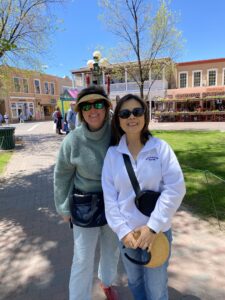
What a quick fulfilling immersion it was… quality time – some of it soaking, seeing old friends in good places, meeting new friends and coworkers, and connecting with new family. A very nice dive into the land of enchantment indeed.
Quote of the Month
“What can you do to reduce your wardrobe’s impact on the planet”
Global Clothing Glut

Crazy to think that our clothes might contribute as much as 8 – 10% of global carbon dioxide emissions, more than aviation and shipping combined. Textiles rely heavily on petrochemical products that are oil and gas derivatives. Polyester has overtaken cotton “as the backbone of textile production.” The World Bank suggests that global clothing sales could increase by 65% by 2030.
Our global society is consuming more clothing than ever, partly due to fast fashion. Worse yet: Much new product and nearly all used product goes to landfills or is incinerated. British shoppers apparently buy more than any other European country… perhaps influenced more by fast fashion. A BBC article queries readers: “What can you do to reduce your wardrobe’s impact on the planet?” The article found that in England, shoppers in the 16 – 24 year-old age range buy clothes online at least once a week.
Most of the impact is related to raw materials: Like 2.5% of the world’s farmland being dedicated to cotton, and 342 million barrels of oil used each year to make polyester. The production of clothes requires 43 million tons of chemicals a year…and major amounts of water, literally thousands of gallons per pair of jeans.
Fast fashion is a term that describes the quick turnover of fashion trends and the move towards cheap, mass-produced clothing. New lines are constantly released and purchased, and wardrobes are overflowing with clothes. Oxfam research suggests that the average Brit has 57 unworn items.

Textiles are the second largest product group made from petrochemical plastics, just behind packaging. Textiles are made of 15% of all petrochemical products. Polyester and nylon ended hundreds of years of cotton’s dominance. The global market for polyester yarn is expected to grow from $106 billion to $175 billion by 2023, a level representing some 92 million tons a year. And the growth has come at major cost. In 2015, polyester production caused the emissions of 282 billion tones of carbon dioxide, triple that of cotton.
Another cost relates to microplastics. Bloomberg NEF reports that clothing made of synthetic fibers is a prime source of microplastic pollution that is especially harmful to marine life. These materials shed plastic particles with every wash and wear. Fully 35% of all the microplastics in the ocean are traced back to textiles. They are the largest source of microplastics today.
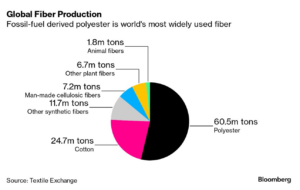
Why is polyester – plastic clothing – so appealing? It is good and hardy. It is versatile and can be fashioned into anything from faux furs to silky dresses and athletic clothes and Gucci skirts. Lots of current clothing is made of textiles that are blends of fibers from polyester, nylon, acrylic, and elastane. This makes these textiles impossible to recycle.
The amount of clothing has ballooned. The U.S. EPA finds that clothing and footwear waste generated by Americans each year rose from 1.4 million tons in 1960, to over 13 million tons in 2018. At least 70% of this ended up in landfills. Often the pace of apparel production exceeds demand, resulting in unsold inventory, overproduction creating a glut of inventory. In one noted case in 2017, a Swedish power plant reportedly “burned mountains of discarded clothing.”
So what are the solutions? They are, in a word, nascent, but important. The United Nations has launched an initiative “the#ActNowFashion Challenge. There is a small but growing movement toward sustainability and ecologically grown cotton. One brand collects and recycles underwear. One of EcoMotion’s podcasts features sloFashion. Some forms of polyester are now made from bioplastics, using natural polymers. Some companies like Patagonia, are working toward sustainability in the textile area. There are a cadre of companies working to take waste textiles and to repurpose them, recovering and processing materials to make new yarn, others are working to produce recycled clothing from discarded clothing.
Seaweed Clothing
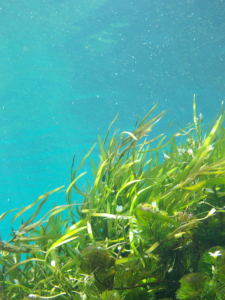
Seaweed, technically “macroalgae,” refers to thousands of species of multicellular, marine algae. It comes in red, brown, and green. One species, kelp (laminaria, provides essential habitat for fisheries; planktonic algae plays a vital role in capturing carbon and producing half of the world’s oxygen. Seaweed is also eaten. The Food and Agriculture Organization reports that world production of seaweed for food in 2019 was over 35 million tons, with 58% produced in China, followed by Indonesia, South Korea, and the Philippines.
Kelp is in focus. It is a carbon negative crop. It has huge potential for climate change mitigation. One study determined that covering 9% of the world’s oceans with kelp forests could provide enough bio-methane to replace all of today’s needs for fossil fuel energy, removing 53 billion tons of CO2 per year and restoring preindustrial levels.
Seaweed is abundant in our oceans, growing at extraordinary rates in salt water while sequestering CO2. It is high in iron, calcium, iodine, vitamins A, C, E, B12… and more. As such, it has been a diet staple in Asia since prehistoric times. It’s loaded with essential substances like trace elements, amino acids, minerals, antioxidants, and vitamins. Humans have harvested it for thousands of years. It has been used for medicine, food, fertilizer, fuel, skincare, and more. In Ancient Rome it was used to dress wounds. Today seaweed is even being used to make bio-based skis.
In World War 1, manufacturers experimented with different materials to fortify fabric for soldiers. In the 1600s. Japanese textile makers began to experiment and use seaweed fabric also to fortify clothing. Today seaweed clothing is an alternative to fossil fuel-based polyester and nylon, which together make up 60% of all clothes.
Kelp fabric is not purely seaweed. It is made of two sustainable parts: tree cellulose and kelp. It is made by spinning natural cellulose from beech or eucalyptus trees and seaweed together, creating a soft, stretchy, durable fabric yarn that is used to weave fabrics. The resulting material is biodegradable, absorbent, soft, and breathable. It’s an alternative to cotton and wool.
One Seaweed fabric supplier is SeaCell. Its product is 81% lyocell and 19% seaweed. It has been used by Lululemon in some of its yoga clothes for nearly two decades. It is now also being used for bedding and towels. It’s also making its way into mattresses. Seaweed has the potential to replace plastics. Not just for clothing, but for things like plastic bags and film alternatives.

There are other benefits of using seaweed. The SeaCell product is smoother and silkier than wool or cotton. It features breathability, moisture wicking, durability, and high levels of sun protection. Of course, seaweed requires no freshwater, in stark contrast to cotton. A single cotton t-shirt can require hundreds of gallons of water in its production.
Lululemon advertised its use of seaweed-based products, but got caught with unsubstantiated claims of it being anti-inflammatory and having anti-bacterial properties. Lululemon still carries the fabric in a line of its clothing, but without the medicinal claims. It now focuses on comfort and breathability. The New York Times calls seaweed “an increasingly common sustainable, regenerative, natural product.” Demand for fabric made from seaweed is reportedly “off the charts.”
South Korea’s Solar Bike Path

It’s in South Korea, in the median of a busy highway… a 20-mile long bike path covered by a canopy of solar panels. The highway and bikeway run between Daejon and Sejong, the latter being the administrative capital of South Korea. The continuous canopy of panels shields cyclists from the sun while generating power for highway signage and area lighting. Some simply call it a roof on top of a bike road.
It isn’t the first solar bike path. The Netherlands Sola-Road employs a design in which bicyclists ride on top of solar panels. In South Korea they ride beneath them.
The South Korean system is accessed through subterranean tunnels that allow cyclists to enter and exit the bike path. Barriers protect riders from three lanes of traffic on either side. Naturally concerns over air quality from ICE car fumes will subside as EVs gain popularity and use.
Plugging Into Streetlights
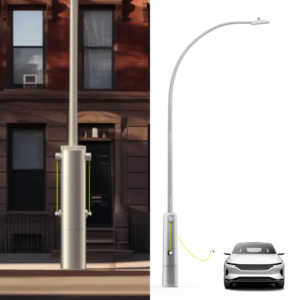
Image Courtesy of Voltpost
Double duty. Instead of just providing light, what if streetlights could also provide EV changing stations? The power is there and highly efficient LEDs have freed up capacity for charging. Enter the streetlight-mounted charger by startup Voltpost. After small pilots in New York and Detroit… tough place to build EV stations… its modular street-proofed system is commercially available.
Voltpost and others are addressing fundamental urban EV realities. It is uncommon for city dwellers to have their own driveway or garage where they can charge an EV. So consumers will want street parking and street charging. Cities have underground power grids, adding to installation costs. It’s expensive and challenging to install new chargers in urban environments, cutting trenches into streets, curbs, and sidewalks.
It’s hard enough to find parking, and inconceivable to easily find parking and EV charging. But streetlights and lampposts are everywhere. Why not meld this supply of locations, with growing demand?
Voltpost has put a lot of time and energy into “protecting its systems from bad actors.” Its power electronics and control systems are contained within a protective aluminum outer casing that completely surrounds the light post. Voltoost uses a 20-foot retractable charging cable mounted 8-feet off the ground, only a short length of which is exposed to vandals or thieves.
In Europe, Ubitricity has installed thousands of lightpost-mounted chargers. In Los Angeles, there are 600 lightpost-mounted chargers that have been installed since 2022, chargers provided by Flo, ChargePoint, and Shell Recharge.
EV Highlights from Oakland and Shenzhen

Image Courtesy of Zum
Just days ago, Oakland, California was proud to report that its school district is the first in the country to have an all-electric school bus fleet. Thanks to collaboration between the Oakland Unified School District and Zum, a student transportation company, all 74 of the District’s buses are fully electric. The buses will also be providing energy to the City and utility when not in use, partnering and providing Pacific Gas and Electric Company with 2.7 MW of VGI (Vehicle Grid Integrated) capacity from Zum’s bus facility in Oakland.
Many families in Oakland are disadvantaged and affected by high rates of asthma and exposure to air pollution from diesel fuels. Cleaner student transportation is considered a game changer, providing greater equity and affording students from disadvantaged neighborhoods with freedom from bus emissions and thus greater health, the backbone of a stronger chance of success in the classroom.
Zum notes that moving students is equivalent to the largest mass transit system in the nation, U.S. buses transport 27 million students twice daily. Over 90% of the nation’s ~500,000 school buses run on carbon-based fuels, releasing over 8.4 million tons of greenhouse gases annually. Zum’s goal is to electrify 10,000 school buses and to supply up to one million kWh to the grids annually.
It’s called the “City of Superchargers.” It’s BYD’s hometown. Shenzhen is China’s third largest city after Shanghai and Beijing. And now its EV charging network has surpassed gas stations, the number of ultra fast DC chargers there exceeds the number of gas stations. Shenzhen now has 362 super charging stations. And one of those, a Shell/BYD project near the airport, has 258 charging dispensers.

For the past several years, Shenzhen has experienced a 10% year-after-year increase in charging infrastructure and access. The government has supported the transition, expanding the number of NEVs in the City (“new energy vehicles”) to 970,000 units in December 2023, now approximately 60% of the automotive market.
Batteries Becoming Largest Form of Grid-Scale Storage
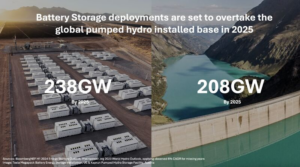
Less than seven years since the world’s first large battery was installed in Australia in 2016, the Tesla “big battery” at Hornsdale, the capacity of battery storage is expected to soon overtake that of pumped storage hydro facilities worldwide. The milestone is expected to occur in 2025, while batteries have been derided as immature technology. They’ve come a long way in a short time.
In 2020, there was a total capacity of 18 GW of Battery Energy Storage Systems (BESS), versus 160 GW of Pumped Hydro Energy Storage (PHES). Fully 90% of the total was PHES. But by 2024 the PHES share had shrunk to 56%… with 157 GW of BESS and 197 GW of PHES. In 2025, and given exponential growth of BESS, one noted that, “the balance tips forever.” Batteries are becoming a significant factor on the power grids of today. BESS technology is arguably just as mature and as bankable an asset class as PHES which has been the gold standard for investors.
Capacity is one thing, storage duration is another. Most battery systems in Australia have only 1 – 2 hours of storage, reflecting their investors’ focus on selling grid services such as frequency control and system security. Now there are more four-hour systems, and more and more eight-hour battery to capture and shift solar and wind power for later use.
Flanigan’s Ego-Logic Podcast Updates

Use the links below to check out our recent podcasts. And you can always go to Spotify and type in “Ted Flanigan” to find our library of podcasts.
Recently Released:
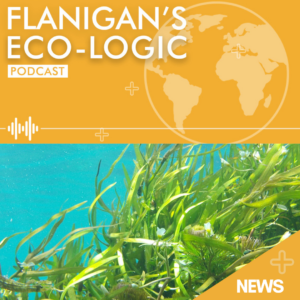
In EcoNet News, Volume 26, Issue #5, Ted shares his highlights from his trip to the land of enchantment, Sante Fe, New Mexico, to visit his daughter Sierra who is living there. He also highlights the global clothing glut, seaweed clothing, South Korea’s solar bike path, streetlight-mounted EV chargers, the first school district in the country in Oakland, CA to have an all-electric school bus fleet, Shenzhen’s EV charging network surpassing gas stations, and batteries becoming the largest form of grid-scale storage.
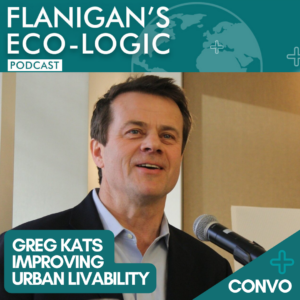
In this episode of Flanigan’s Eco-Logic, Ted speaks with Greg Kats, Founder and CEO of the Smart Surfaces Coalition, a non-profit organization promoting the adoption of urban “smart surfaces” to improve urban livability. He is also a businessman, environmentalist, played substantial roles in developing the clean energy and green building industries, and is a long-time thought leader and investor in the transition to a low carbon economy.
Greg played a large role in designing and developing LEED, the green building standard, and was hired by the World Bank to guide the creation of a new World Bank green building design standard. He was later hired by the Enterprise community partners to guide development of the first and still leading green design standard focused on low income housing, called Green Communities. Ted highlights Greg being the Founding Chairman of the International Performance Measurement and Verification Protocol (IPMVP), who built the Protocol into the global energy and water efficiency design and verification standard used in over $100 billion in building upgrades.
He founded the Smart Surfaces Coalition in 2019 to slow global warming, redress social inequity, and build urban resilience. It is a powerful collection of 40 leading organizations in urban health, sustainability, equity, architecture, energy, water, and urban policy dedicated to the adoption of “smart surfaces,” a set of technologies that allow cities to better manage sun and rain, save money, and create more livable communities. Smart surface solutions include a strategic combination of reflective roofs and pavements, porous pavements, green roofs, solar photovoltaics (PV), and trees, enabling cities to lower their temperatures despite global warming, as well as create increasingly resilient and livable infrastructure.
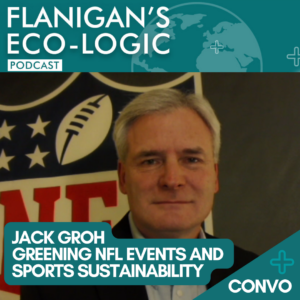
In this episode of Flanigan’s Eco-Logic, Ted speaks with Jack Groh, Director of Environmental Programs for the National Football League (NFL). He is also the Senior Vice President of Strategy for Legacy Sustainability, an independent consultancy that he and his wife, Susan Groh manage to develop and implement climate mitigation and adaptation strategies around major sporting events.
Jack and Susan have been minimizing the environmental impacts of major sports events for 30 years, including the NFL’s major special events. They are widely recognized for the unique and impactful community projects they develop and have consulted on sustainable transportation development, municipal waste diversion, building sustainability, and renewable energy.
Based in Warwick, Rhode Island, Jack and Susan have been at the forefront of making the NFL and other organizations more environmentally conscious. In 1993, they developed the first environmental initiatives ever implemented at any professional sports league in the United States at Super Bowl XXVIII in Atlanta, Georgia. Their journey began with simple recycling projects during the Super Bowl and evolved into making the game the greenest professional championship in the world. Their efforts extend beyond visible actions, including recycling, food recovery and material repurposing, to making a substantial difference in the environmental and community impact of large events.
Through their independent consulting efforts at Legacy Sustainability, they aim to leave each community better than they found it and inspire others to do the same. Some of the green legacy programs they leave behind in every community include planting trees, creating pollinator gardens, habitat restoration, equipment donations and school supply programs, recycling and composting, taking excess food and drink off to local food banks, and using renewable energy and helping organizations get renewable energy certificates. Jack highlights the Miami Coral Reef Project, Super Kids Super Sharing event, and the NFL Green Super Bowl LVIII Program launch.
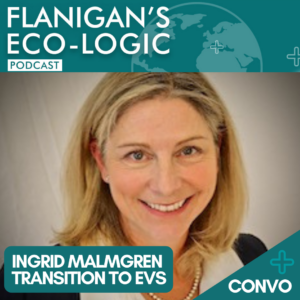
In this episode of Flanigan’s Eco-Logic, Ted speaks with Ingrid Malmgen, Senior Policy Director at Plug in America, a nonprofit organization with a mission to accelerate the transition to affordable and accessible plug-in vehicles and charging through education, advocacy, and research. Ingrid has over a decade of experience advancing sustainable energy and transportation electrification through research, utility regulatory proceedings, and legislative advocacy.
She shares her story of landing in the EV space through her works with energy efficiency and utilities. She found herself running cost benefit analyses of EVs, studying the impact on the grid, cost savings to consumers and drivers, impacts on public health, and social cost of carbon.
She and Ted discuss the broader societal benefits of EVs, the history and genesis of Plug in America, and how EVs are a critical component to a sustainable and equitable energy future. Ingrid also shares a broadened view of vehicle grid integration, and her excitement to continue fighting for policy change at Plug In America.
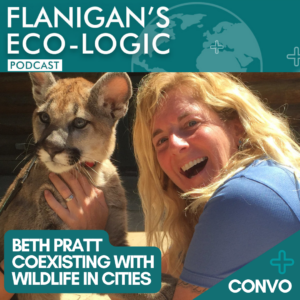
In this episode of Flanigan’s Eco-Logic, Ted speaks with Beth Pratt, the Regional Executive Director of the California Regional Center of the National Wildlife Federation. She is a lifelong advocate for wildlife, and has worked in environmental leadership roles for over twenty-five years. She has also spearheaded the #SaveLACougars campaign to collaborate, fund, and build the Wallis Annenberg Wildlife Crossing, the largest crossing in North America—and potentially the world—to help save a population of mountain lions from extinction. The initiative has raised a half a billion dollars in private funding to advance wildlife crossings across California and the country.
Before joining the Federation in 2011, she worked on sustainability, green building, and climate change programs for Xanterra Parks & Resorts in Yellowstone as its Director of Sustainability. Under her leadership, Yellowstone’s environmental programs received environmental achievement awards from the National Park Service three years in a row. Prior to her role in Yellowstone, she served as the Vice President/CFO for the non-profit Yosemite Association (now Yosemite Conservancy) in Yosemite National Park.
Although most of her career has been spent in national parks, she shares that her main conservation priority is now focused on urban wildlife conservation and creating coexistence strategies within urban spaces. She believes that the future of conservation is about the integral link between wildlife and people – and cities are vital to forging those links.
